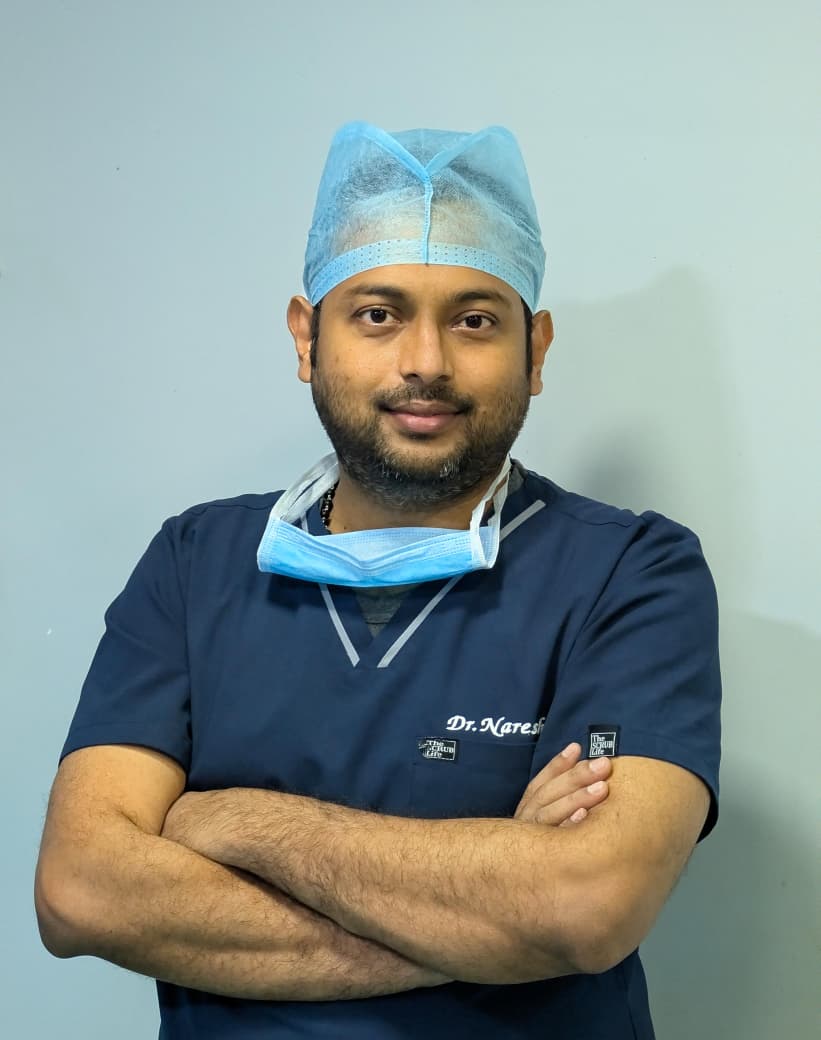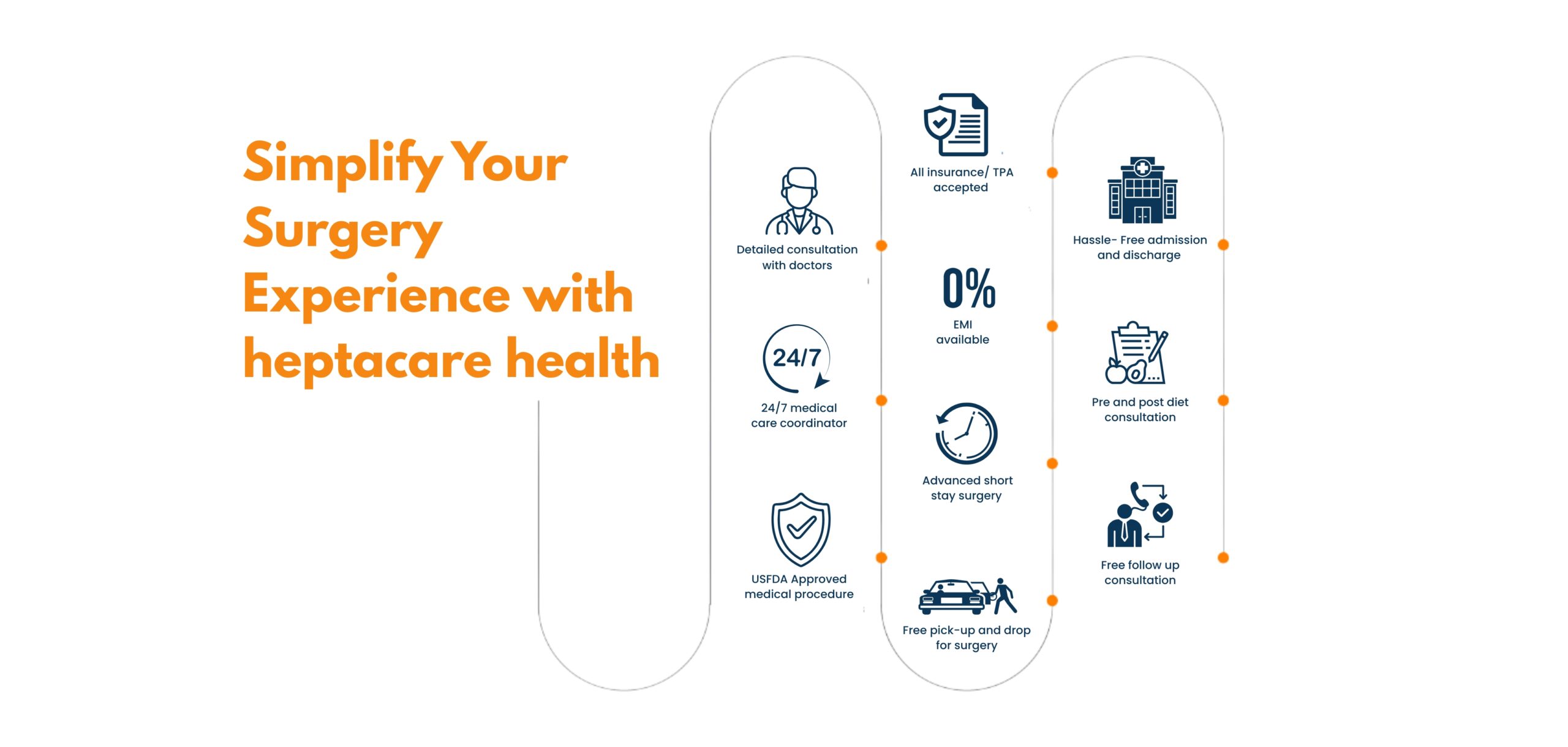A sebaceous cyst is a small, noncancerous lump beneath the skin caused by blocked sebaceous glands, often filled with oily or keratin material.
Do you feel that your chest is increasing in size and look more like female breasts? These symptoms may indicate gynecomastia (man boobs) and the condition can be bothersome for males. If you have enlarged breasts, you can get in touch with Heptacare Health.
Happy Patients
Disease
Hospitals
Cities
Gynecomastia, also known as man boobs or enlarged breasts, is a condition in which breast tissues start to develop in males due to hormonal imbalance or higher levels of estrogen. These overdeveloped glandular tissues can cause social and personal distress in males, making them feel uncomfortable or self-conscious.
Gynecomastia progresses gradually in four grades-
Besides the above classifications, gynecomastia is also divided into true and pseudo-gynecomastia. In true gynecomastia, only breast glandular tissues are present. Unlike this, in pseudo-gynecomastia, only fat tissues are present in the chest, giving the appearance of female breasts. Generally, when gynecomastia presents, the individual often has both glandular and fat tissues.
To identify gynecomastia and differentiate between true and pseudo-gynecomastia, the doctor may do the following:
These tests aid the plastic surgeon in determining the safest approach for gynecomastia Surgery.
The most suitable method for gynecomastia Surgery is chosen by the doctor based on individual circumstances.
The standard and effective solution for gynecomastia is the surgical removal of overgrown breast tissues in males. The procedure involves removing the breast glandular tissues and fat to improve the chest contours. Gynecomastia surgery is performed on an outpatient basis and takes around 45-60 minutes approx.
The surgery involves administering general anesthesia and making a small incision around the areola to access the internal structures. A scalpel is used to excise the breast tissues, and the liposuction cannula is used to break down and remove the fat tissues. Once the required contours are achieved, the incision is closed with stitches (usually dissolvable) or left open to heal. The wound is covered with a bandage, and the patient is kept under observation for a few hours until the effects of anesthesia wear off.
Here are the top advantages of choosing male breast reduction surgery to reduce enlarged breasts over other treatment options.
The recovery after gynecomastia Surgery will take around 2 to 4 weeks. The exact duration will vary for each patient depending on the extent of surgery and the patient’s healing abilities.
The healing process will continue in the upcoming weeks, and the patient may need to take several precautions until the final results become apparent.
Typically, gynecomastia surgery is safe and has minimal risks. Still, there are some potential risks of the procedure, and some complications may arise during or after the surgery. These common risks and complications may include the following:
There may be other side effects of gynecomastia Surgery, such as swelling, bruising, inflammation, redness, etc., which are temporary and often resolve on their own without intervention. However, if these side effects persist for a long time, it may indicate infection or other complications. Therefore, it’ll be best to consult the doctor.
After male breast reduction surgery, the patient is advised to follow several guidelines for a smooth and successful recovery.
Immediately after the surgery, the patient will be on a liquid diet. The doctor will recommend switching to a solid diet gradually. The patient needs to eat healthy foods and drink plenty of water to provide the necessary nutrients. It’s also important to avoid drinking alcohol and smoking after the surgery for at least a month to get the desired results.
For the first 24 hours after surgery, the patient is advised to get plenty of rest. After that, restrain from performing any type of strenuous activity such as driving, operating machinery, or lifting heavy weights. The patient doesn’t have to stay in bed all the time and is free to walk and climb stairs. But it’s important not to push the body’s limits. As the body heals, the patient will be able to resume all activities without any hassle.
To ensure that the chest tissues stay in place and swelling subsides quickly, the doctor will suggest wearing compression garments for at least 2-3 weeks throughout the day. Over time, the patient can limit the usage of the garment up to 12 hours.
Throughout the recovery process, the patient will have to avoid taking medications like ibuprofen, aspirin, etc. These medicines can interfere with the blood clotting system and increase the risk of complications. If the patient needs to take other medicines on a regular basis, those should also be cleared by the surgeon.
On average, the gynecomastia surgery cost varies for each patient due to the following factors:
It’s important to note that cost should not be the only determining factor for gynecomastia Surgery. The patient should consider the quality of care at the surgical facility and the experience of the plastic surgeon. These factors will affect the overall surgery experience and also determine the success rate of the treatment procedure.
Leaving gynecomastia untreated usually has both physical and psychological impacts on the individual.


Based on 7721 Recommendations | Rated 4.68 Out of 5
Happy Patients
Clinics
Cities
Surgeries
Doctors
Hospitals

A beard transplant is a cosmetic procedure that restores or enhances facial hair by transplanting hair follicles from the scalp to the beard area.

Vaginoplasty is a surgical procedure that tightens or reconstructs the vaginal canal to improve function, appearance, or both.

Treat anal fistula with safe, advanced procedures.
Minimally invasive care with faster recovery.

A breast lump is a swelling or mass in the breast that can be benign (non-cancerous) or, in some cases, a sign of breast cancer.

A tummy tuck, or abdominoplasty, is a cosmetic surgery that removes excess fat and skin from the abdomen and tightens the muscles for a flatter, firmer tummy.

A double chin is a layer of excess fat beneath the chin, often caused by weight gain, ageing, or genetics, and can be reduced through cosmetic treatments or lifestyle changes.

A sebaceous cyst is a small, noncancerous lump beneath the skin caused by blocked sebaceous glands, often filled with oily or keratin material.

A lipoma is a soft, benign lump made up of fatty tissue that grows slowly under the skin and is usually painless and harmless.

Liposuction is a cosmetic surgery that removes excess fat deposits from specific body areas to improve body shape and contour.

Lipomas are soft, moveable, and grow slowly; imaging may confirm.
No, lipomas usually remain or grow slowly over time.
They can be removed by surgery, liposuction, or sometimes steroid injections.
Yes, some people inherit a tendency to develop multiple lipomas.
● lipoma laser surgery cost in Vizag ● low-cost lipoma surgery in Hyderabad ● cashless lipoma treatment near me ● painless lipoma surgery in Vijayawada ● lipoma treatment with insurance in Vizag ● lipoma removal surgery cost in Hyderabad ● lipoma operation packages in Vijayawada ● affordable lipoma treatment near me ● lipoma laser treatment clinic in Hyderabad ● lipoma doctor consultation charges in Vizag ● best lipoma surgery cost in Vijayawada ● lipoma treatment hospital near me ● lipoma laser operation price in Hyderabad ● low-cost lipoma laser treatment in Vizag ● lipoma removal cost near me ● lipoma treatment with EMI in Vijayawada ● lipoma surgery specialist near me ● lipoma surgery packages in Hyderabad ● lipoma treatment clinic near me ● lipoma laser surgery near me
Disclaimer: **The result and experience may vary from patient to patient.. ***By submitting the form or calling, you agree to receive important updates and marketing communications.
Getting an accurate diagnosis can be one of the most impactful experiences that you can have.

cure with care
Copyright © 2025. All rights reserved.
Consult with our expert surgeon for more than 50+ diseases
Happy Patients
Hospitals
Cities